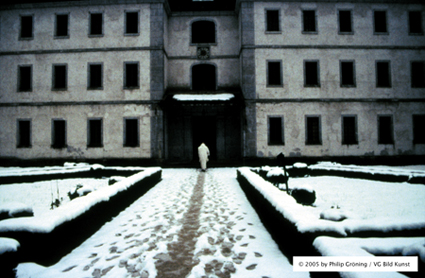|
Reviews of Recent Independent, Foreign, & Documentary Films in Theaters and DVD/Home Video
Photographed, Edited, Written, Produced & Directed by: Philip Gröning. Released by: Zeitgeist Films. Language: French & Latin with English subtitles. Country of Origin: Germany. 162 min. Not Rated. Even in the passionately religious world of the European Middle Ages, the Carthusians, or monks of the Chartreuse, were unusual – a religious order that combined community life with the vocation of a hermit, spending most of their days in individual cells in their cloisters. They still live thus, praying, studying, and working in the tiny individual gardens outside, only enjoying conversation and social contact once a week. The original and greatest Carthusian monastery is the Grande Chartreuse in the French Alps. Although the location has been occupied for centuries, the present vast, rambling, walled complex dates from over 300 years ago. German filmmaker Philip Gröning sought permission to film there 16 years before he was allowed to begin filming in 2000. The resulting film is a spare, simple, impressionistic rendering of a bare, silent, contemplative place, without commentary, dialogue, nor incidental music. Often the microphones strain to catch any sound at all. Only for brief interludes are the monks recorded speaking while on their weekly walks. Nearly always the viewer is an outsider, listening in on rare playful conversations from a distance. Yet this is a rich film in many ways. The sequences of visual impressions, mostly in takes of only a few seconds, create a series of rhythmic cycles of images re-creating the cycle of monastic life: prayer alternates with services in the chapel, with times of study and work, and occasional recreation. While it is almost impossible to film contemplative silence, Gröning gets as close to this extraordinary achievement as anyone can. There are charming vignettes of the community members, especially the ancient and eccentric lay brothers who tend to the needs of the monastery (and its cats). Individual monks stare silently at the camera, unsure whether to meet its gaze or not. Towards the end of the film an elderly monk speaks briefly with simple gentleness about his faith, faith that could lead him to see even his own blindness as a gift of God. Even the occasional incongruous notes – the novice practicing chants with an electronic keyboard, the administrator-monk checking accounts with a laptop, and the central heating radiators in some cells – add to the picture. There is much that Gröning deliberately chooses not to explain. We experience no personal contact with the monks as individuals, save at the very end, and gain no insights as to what brought them into the monastery, or why some choose to stay when many arrive as novices and soon leave. The film supplies no background to the order, no sense of its literature, no explanation of its liturgy. A viewer learns far less about the reasons for becoming a Carthusian than could be learned by a cursory study of its traditions. That may, in the end, be the point – or at least the message that Gröning wishes to leave. Only by respectful, patient observation and listening can we possibly win insights.
However, the film is ultimately a visually stunning experience. It has the rare beauty that can only be achieved when great simplicity of vision meets great artistic sensibility. It is no surprise that the film has won multiple awards both in Germany and across the world. A religious scholar might have reservations about turning a religious experience into an aesthetic one. Yet Gröning may ultimately be right to do this. In an unspiritual age, the aesthetic may be the only way to convey the life of the spirit.
Euan Cameron,
Academic Dean and Henry Luce III Professor of Reformation Church History,
Union Theological Seminary
|

